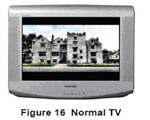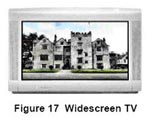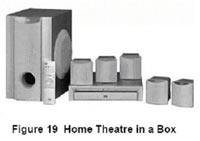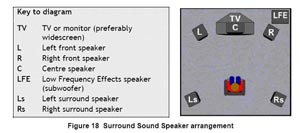1. What is HD DVD?

HD DVD or High-Definition DVD is a high-density optical disc format designed for the storage of data and high-definition video. It is designed to be the successor to the standard DVD format, and is derived from the same underlying technologies. It can store about 3 1/2 times as much data as its predecessor.
HD DVD-ROM has a single-layer of 15 GB, a dual-layer capacity of 30 GB, and a 51 GB single-sided triple-layer disc. HD DVD-R and HD DVD-RW has a single-layer capacity of 15 GB, a dual-layer capacity of 30 GB. The HD DVD-RAM has a single-layer capacity of 20 GB. Like the original DVD format, the data layer of an HD DVD disc is 0.6 mm below the surface physically protecting the data layer from damage. The numerical aperture of the optical pick-up head is 0.65, compared with 0.6 for DVD. All HD DVD players are backward compatible with DVD and CD.
PHYSICAL SIZE |
SINGLE LAYER CAPACITY |
DUAL LAYER CAPACITY |
12 cm, single sided |
15 GB |
30 GB |
12 cm, double sided |
30 GB |
60 GB |
8 cm, single sided |
4.7 GB |
9.4 GB |
8 cm, single sided |
9.4 GB |
18.8 GB |
HD DVD is currently in a format war with rival format Blu-ray Disc
2. What is Blu-ray Disc?

A Blu-ray Disc (also called BD) is high-density optical disc format for the storage of digital information, including high-definition video.
The name Blu-ray Disc is derived from the blue-violet laser used to read and write this type of disc. Because of its shorter wavelength (405 nm), substantially more data can be stored on a Blu-ray Disc than on the DVD format, which uses a red (650 nm) laser. A single layer Blu-ray Disc can store 25 gigabytes (GB), over five times the size of a single layer DVD at 4.7 GB. A dual layer Blu-ray Disc can store 50 GB, almost 6 times the size of a dual layer DVD at 8.5 GB
3. Why can't the content in DVD be duplicated in the usual ways?
Generally ,DVD movies adopt a copy-protection technology ,we call it CSS.
Digital copy protection is provided by the Content Scrambling System (CSS), which is used to scramble the video data on a DVD-Video disc. Each video title set (VTS) can be selectively scrambled using a unique key. Each unique title is assigned one Disc Key and up to 99 Title Keys (one per VTS), which are stored on the disc in encrypted form. In the decoder, the original keys are obtained by decryption and used to descramble the data . For DVD-ROM drives, the MPEG-2 decoder challenges the drive and receives the necessary keys for decryption.
This ensures that only approved hardware/software can be used. The keys used should be unique for every disc title and are encrypted by the CSS Licensing Authority and, usually, the scrambling is carried out during glass mastering. Security is vital and the keys used plus the encryption algorithms must be kept secret. Only those companies involved in designing hardware and software for CSS encoding and/or decoding need information on the algorithms and systems used.
With the powerful technology, we have managed to decode the copy protection. You can clone your DVDs with DVD-CLONER comfortably.
4.How to get the best DVD quality?
To get the best quality involves the use of widescreen display monitors and a surround-sound audio system.
 a. Widescreen TVs a. Widescreen TVs
Traditional televisions have a 4:3 aspect ratio, but movies are filmed in widescreen at up to about 2.35:1.
Widescreen televisions have a 16:9 (1.85:1) aspect ratio and allow movies to be displayed full width with no black bar or only a narrow black bar near the top and bottom. TV broadcasts in Europe have been gradually improved towards the 16:9 format for most new programs. As a result, widescreen TVs are quite common in Europe, but it is not the case in the USA where screen size seems to be more important.
 Widescreen TVs will display the source video in any of the following screen formats: Widescreen TVs will display the source video in any of the following screen formats:
? 4:3 format with black bars at the side of the screen.
? 14:9 format with narrower black bars at the side and the top and bottom of a 4:3 image is cut off.
? 16:9 format has the full width but the top and bottom of a 4:3 source video is cut off.
? 16:9 format (sometimes called Movie Expand) where the full height and width of the source video is displayed. This is suitable for anamorphic video such as output by a DVD player from a widescreen DVD-Video disc.
A trend has recently started to integrate other hardware with the TV. Thomson, for example, has released a widescreen TV with an integrated DVD player.
b. Surround-Sound
 A full surround-sound system requires six speakers and a surround-sound amplifier. With conventional speakers this can be both expensive and cumbersome. Therefore there is now a range of solutions comprising very small speakers plus a sub-woofer. Some manufacturers offer DVD players with a full surround amplifier and speaker system. A few widescreen TVs include a centre speaker as well as stereo speakers and separate surround speakers. At least one model provides a wireless link to the surround speakers to avoid wires trailing across the living room floor.There is a diagram of a typical surround sound home cinema set-up with 5 speakers and a subwoofer. A full surround-sound system requires six speakers and a surround-sound amplifier. With conventional speakers this can be both expensive and cumbersome. Therefore there is now a range of solutions comprising very small speakers plus a sub-woofer. Some manufacturers offer DVD players with a full surround amplifier and speaker system. A few widescreen TVs include a centre speaker as well as stereo speakers and separate surround speakers. At least one model provides a wireless link to the surround speakers to avoid wires trailing across the living room floor.There is a diagram of a typical surround sound home cinema set-up with 5 speakers and a subwoofer.
c. Home-Theatre-in-a-Box Systems
 There are now many affordable home-theatre-in-a-box systems for DVD available. These comprise a DVD player, surround sound amplifier, 5 satellite speakers and a subwoofer. In addition to a widescreen TV they offer a complete home cinema solution that can make best use of DVDs with Dolby Digital surround sound content and can reproduce most of the experience normally found in a cinema. They are also easier to set up with fewer cables needed. There are now many affordable home-theatre-in-a-box systems for DVD available. These comprise a DVD player, surround sound amplifier, 5 satellite speakers and a subwoofer. In addition to a widescreen TV they offer a complete home cinema solution that can make best use of DVDs with Dolby Digital surround sound content and can reproduce most of the experience normally found in a cinema. They are also easier to set up with fewer cables needed.
DVD-CLONER can clone the original DVDs completely, e.g. picture quality, audio, subtitle and so on. The backup disc will give you a perfect reproduction of the original DVD.
DVD-CLONER
5. Hot movie websites .
http://www.visimag.com/
http://www.fwfr.com/
http://www.iofilm.co.uk/
6. What is D5 and D9? What is the difference? Any other formats?
There are 4 standard formats. D10 and D18 are not as common.
A DVD-5 (single sided) DVD-Video disc will hold nominally 133 minutes of high quality MPEG-2 encoded video, together with three surround-sound audio channels and four subtitle channels. (Without video compression one DVD-5 disc would hold only about 3 minutes of video).
A DVD-9 (dual layer) disc increases the playing time to 240 minutes of continuous video.
A DVD-10 (double sided) disc will hold a nominal 133 minutes on each side (ie 266 minutes in all), but the disc needs to be turned over to play the other side.
A DVD-18 (dual layer, doubled sided) disc can hold 240 minutes on each side and the disc also needs to be turned over to play the other side.
Most DVD is D9 or D5 format. Our software can clone D9 to just ONE DVDr/rw disc (D5 format) without evident losing.
7. what are Menu and Navigation?
Interactivity on a DVD-Video disc is provided as menus, which allow the user to select particular sequences or functions . Each menu comprises a still image or video loop as background plus up to 36 rectangular buttons, which use subpictures for highlighting. Different versions of the menu are required for widescreen, letterbox, and pan & scan mode. In this case only 12 buttons are available for each, making 36 in total. The user selects buttons (instead of moving a cursor) and use the Up/Down/Left/Right arrow keys on a remote control. The three available subpicture colors (the fourth is transparent) can be used to indicate what state the button is in: unselected, highlighted or selected. This provides the necessary feedback to the user. This user interface may be a bit cumbersome but generally makes it easier to use from a remote control device.
By using DVD-CLONER, you can select whether you will save the movies of DVDs only, without keeping menus or not.
8.What’s Double Layer disc?
Double Layer DVD recording brings new capability to your PC. With the ability to store up to 4 hours of high quality MPEG-2 video (or up to 8 hours of MPEG-1 video) or up to 8.5GB of information on a single sided disc with 2 recordable layers. DVD+R DL discs are write once discs of the DVD “+” format, and once recorded they are playable in standard consumer DVD players* and computer DVD-ROM drives.

Supported burner
SONY DRU-700A (recommend)
ASUS DRW-1604P
BenQ DW1600
LG GSA-4120B
NEC ND-2510A |



 a. Widescreen TVs
a. Widescreen TVs  Widescreen TVs will display the source video in any of the following screen formats:
Widescreen TVs will display the source video in any of the following screen formats:  A full surround-sound system requires six speakers and a surround-sound amplifier. With conventional speakers this can be both expensive and cumbersome. Therefore there is now a range of solutions comprising very small speakers plus a sub-woofer. Some manufacturers offer DVD players with a full surround amplifier and speaker system. A few widescreen TVs include a centre speaker as well as stereo speakers and separate surround speakers. At least one model provides a wireless link to the surround speakers to avoid wires trailing across the living room floor.There is a diagram of a typical surround sound home cinema set-up with 5 speakers and a subwoofer.
A full surround-sound system requires six speakers and a surround-sound amplifier. With conventional speakers this can be both expensive and cumbersome. Therefore there is now a range of solutions comprising very small speakers plus a sub-woofer. Some manufacturers offer DVD players with a full surround amplifier and speaker system. A few widescreen TVs include a centre speaker as well as stereo speakers and separate surround speakers. At least one model provides a wireless link to the surround speakers to avoid wires trailing across the living room floor.There is a diagram of a typical surround sound home cinema set-up with 5 speakers and a subwoofer. There are now many affordable home-theatre-in-a-box systems for DVD available. These comprise a DVD player, surround sound amplifier, 5 satellite speakers and a subwoofer. In addition to a widescreen TV they offer a complete home cinema solution that can make best use of DVDs with Dolby Digital surround sound content and can reproduce most of the experience normally found in a cinema. They are also easier to set up with fewer cables needed.
There are now many affordable home-theatre-in-a-box systems for DVD available. These comprise a DVD player, surround sound amplifier, 5 satellite speakers and a subwoofer. In addition to a widescreen TV they offer a complete home cinema solution that can make best use of DVDs with Dolby Digital surround sound content and can reproduce most of the experience normally found in a cinema. They are also easier to set up with fewer cables needed. 







